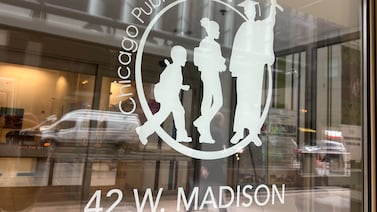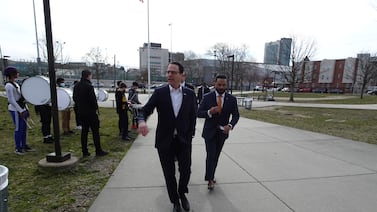In the weeks since Denver Public Schools Superintendent Susana Cordova announced her resignation, powerful people have accused the Denver school board of pushing her out.
Former U.S. Education Secretary Arne Duncan called the Denver board “bad” in a tweet. In a statement, Denver Mayor Michael Hancock and former Mayor Federico Peña called it “dysfunctional.” Fourteen former board members signed a letter accusing the seven current members of interrupting, mistreating, and undermining Cordova.
The relationship between Cordova and the board is more nuanced than the open hostility implied by her supporters. No one shouts at board meetings and disagreements are mostly polite. But Cordova, who spent her entire career in the district, has served a school board majority that came to office with promises to take it in a dramatically new direction.
Board members have championed numerous initiatives but, because of the COVID-19 pandemic, have yet to set a broad strategy. In an effort to be responsive to community concerns, they have asked new questions in more public ways — and yet, at times they have voted against community recommendations and pleas from parents and students.
“What does this board stand for?” said Theresa Peña, a former board president who signed the letter. “There’s a lack of framework for how they want to operate.”
Cordova herself has not blamed the board. She said she’s leaving Denver Public Schools — a district where she rose from student to teacher to superintendent — to take a job in Texas that she wasn’t seeking but that presents an exciting opportunity. She’ll be working for one of her mentors as a deputy superintendent in the Dallas Independent School District.
At a press conference in mid-November, Cordova responded diplomatically to a question about whether disagreements between her and the board played a role in her decision.
“It’s really important in a large, public organization like the Denver Public Schools for there to be honest dialogue, debate, and conflict,” she said. “I think conflict is actually really important in a democracy. And I think it’s also important we work through conflict to get to decisions that we all can support. That’s something I have worked hard on throughout my career.”
Cordova, who was superintendent for nearly two years, has declined further interview requests.
So where are the accusations coming from? Are they based in fact? Or are they — as some have suggested — politically motivated exaggerations? Last November, three candidates backed by the teachers union won seats on the board, “flipping” the majority and wresting control of the board from education reform advocates who held it for years.
In their own statement, board members acknowledged that the shift of power created “challenging situations to manage, with new points of views on the board.”
The board’s only evaluation of Cordova, completed over the summer, conveyed that members wanted her to carry out an “aggressive plan to shift the culture away from the shortcomings of the former ‘reform’ narrative” and believed she had “the requisite competence and skills to do so” — while at the same time questioning whether her staff was “too attached” to the old ways.
“We never had big knock-down, drag-out fights,” board President Carrie Olson said in an interview. “One thing we emphasized was that we wanted to be sure all board members had the opportunity to state what they were interested in and how they wanted to do their work.”
Vice President Jennifer Bacon said what the board has done consistently “is lead with our values and put those things on the table.”
Public agreement
The public letter from the 14 former board members, all of whom are women, very plainly accuses the current board of treating the district’s first Latina superintendent unfairly.
“You simply have to watch a DPS board of education meeting to see the way the superintendent is interrupted, talked over, and routinely discounted by board members,” the letter says.
Asked for examples, former board President Mary Seawell declined to name any, explaining that the letter’s authors don’t want to single out individual board members.
Hancock and former Mayor Peña leveled similar accusations, saying some board members “opposed [Cordova’s] efforts at almost every opportunity” and “mistreated her in public board meetings.” The mayors did not respond to requests for specific examples.
Interruptions in public board meetings are rare. So are raised voices. This Denver school board, like several previous boards, prefers to work out most of the kinks behind the scenes.
On the big policy changes, Cordova has publicly agreed with the board.
She supported a move to ban the handcuffing of elementary school students, pledging that the district would “work toward the elimination of the use of handcuffs.”
When the board took a softer approach to improving low-performing schools, Cordova did not protest. She supported reunifying Montbello and West high schools, which were closed and replaced with smaller schools under the previous superintendent. She helped broker compromises on charter schools, a hot-button issue for the union-backed board members.
She named equity as the focus of her superintendency. She acknowledged the existence of institutional racism in the district, and spoke of how it impacted her and her children. In addition to her own initiatives to include more Black, Hispanic, and Indigenous history in the curriculum, she was responsive to activism by students and educators.
When board members held a press conference to announce they would vote to remove police officers from Denver schools, Cordova attended and spoke in support.
“I am committed to doing my part to bring about the change that’s needed,” she said.
But sometimes, the process to do so was unconventional or frustrating for those involved.
One example was the effort to “reimagine” the district’s controversial school ratings system. A 30-person task force of parents, teachers, and others spent nine months coming up with recommendations, including to get rid of the district’s ratings altogether. The board agreed with that recommendation, but some members balked at other task force suggestions. Some questioned whether there had been enough community engagement.
“It’s very important that through a process like this, we use it as an opportunity to listen more to each other, do less talking past each other, and move beyond labels,” Cordova said. “We need to be able to create space for people with divergent perspectives to work together.”
‘The power to do this well’
Critics who know the district’s history and politics say it’s not what the board does, but how.
Instead of following a cohesive strategy, they say the board governs through what Seawell called “a shotgun of pet projects by different board members:” All-gender bathrooms. Changing the way schools are granted semi-autonomous “innovation status.” Rethinking school choice.
“They still have not developed a new district plan or long-term strategy,” the mayors wrote.
It’s true that the board has not created a new strategic plan to replace the Denver Plan 2020, which debuted in 2014 and is set to expire at the end of this year. The board held a retreat at district headquarters in January to start that work. Several board members expressed concern about the very criticism now being leveled against them.
Barbara O’Brien, elected in 2013 and the board’s longest-serving member, said she worried that passing too many resolutions dilutes the impact of the changes. Angela Cobián said the board needed to balance a sense of urgency with a dose of reality.
“There needs to be an understanding of: we can’t do 100 things,” she said.
Cordova agreed. With multiple resolutions and “overlapping bodies of work,” the superintendent said “it feels like you’re doing everything, but you can’t assess where you’re not doing work.”
When COVID-19 hit just two months later, the board shelved its work on a new strategic plan. Instead, it developed three “crisis priorities” to guide the superintendent’s work during the pandemic: ensure the physical and mental health of students and staff, and ensure students — especially historically underserved students — are learning and not falling behind.
“I hate to always add, ‘and the pandemic,’ but really — ‘and the pandemic,’” board President Olson said. “We all came together around the crisis priorities.”
But even if the board hasn’t put a vision down on paper, Vice President Bacon said its actions have sent a strong message. While some may see all-gender bathrooms or removing school police officers as unconnected issues, Bacon said there is a unifying theme.
“Beyond what it may seem like is surface issues, there is a strong focal point for all of us to say we will acknowledge what our students’ experiences are, which is a different direction than boards of the past have been operating in,” Bacon said in an interview.
Olson called the board a “grassroots elected school board.” The board, she said, is made up of former teachers, current parents, a recent Denver Public Schools alumnus, a reverend, a lawyer, a child of immigrants, and a former Colorado lieutenant governor.
“I see us as seven strong personalities who care about our students in our schools,” Olson said. “Maybe we’re bringing up different things in different ways. It’s a different kind of board.
“We might not be acting in a way that people recognize as effective board governance,” she said, “but we have the power to do this well.”







